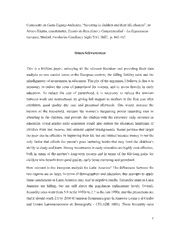
Investing in children and their life chances PDF
Preview Investing in children and their life chances
Comments on Gosta Esping-Andersen, “Investing in children and their life chances”, in Alvaro Espina, coordenador, Estado de Bien Estar y Competitividad – La Experiencia Europea, Madrid, Fundación Carolina y Siglo XXI, 2007, p. 162-167. Simon Schwartzman This is a brilliant paper, surveying all the relevant literature and providing fresh data analysis on two crucial issues in the European context, the falling fertility rates and the misalignment of investments in education. The gist of the argument, I believe, is that it is necessary to reduce the costs of parenthood for women, and to invest heavily in early education. To reduce the cost of parenthood, it is necessary to reduce the tensions between work and motherhood, by giving full support to mothers in the first year after childbirth, good quality day care and preschool aferwards. This would increase the income of the household, increase the women’s bargaining power regarding men in attending to the children, and provide the chidren with the necessary early entrance in education. Good quality early education would also reduce the education handicaps of children from low income, low cultural capital brackgrounds. Social policies that target the poor can be effective in improving their lot, but are limited because money is not the only factor that affects the parent’s poor nurturing habits that may limit the children’s ability to study and learn. Strong investments in early education are highly cost-effective, both in terms of the mother’s long-term income and in terms of the life-long gains for children who benefit from good quality, early home nurturing and preschool. How relevant is this European analysis for Latin America? The differences between the two regions are so large, in terms of demographics and education, that attempts to apply these conclusions to Latin America may lead to negative results. Fecundity rates in Latin America are falling, but are still above the population replacement levels. Overall, fecundity rates went from 5.9 in the 1950s to 2.7 in the late 1990s, and the projections are that it should reach 2.1 by 2050 (Comisión Económica para la America Latina y el Caribe and Centro Latinoamericano de Demografia - CELADE 2001). These fecundity rates 1 mean that Latin America is not facing a problem of demographic explosion any longer, and has yet to face the problems of demographic involution. As we can see in the data from Brazil, this fall is much stronger among the more educated and richer segments than among the poorest. Women that do not work have more children, and, in principle, should have more time nurturing them at home. However, large families are are also very poor and unaducated, and it is unlikely that they would be able to provide their children with the emotional and cultural support they would need. Figure 1 – Brazil, population census, 2000 2 Figure 2 – Brazil, population census, 2000 In most Latin America, admission to basic education is approaching 100%, and preschool and secondary education enrolments are also growing. However, the quality of education is very bad, as shown by PISA and other national assessments, and students drop out in large numbers at ages 14 and 15. 3 Until recently, there was a general consensus that the main priority was to improve the quality of basic education, with more investments, better teaching practices, etc. This consensus is being challenged by several factors. The first is the importance of preschool, as a precondition for life-long achievements, as stressed by Heckman and others (Cunha et al. 2005). The second is that the education requirements in the job market are moving up, and a secondary degree is becoming the minimum requirement to obtain any kind of regular job. The third are the findings, by Hanushek and others (Hanushek, Kain and Rivkin 1999), that investments in teacher salaries and other education inputs do not lead necessarily to better education outcomes. There is also the fact that there are many persons that have dropped out of school without the mininum learning requirements, and need support to be brought back to education and the job market. Finally, the notion (unwarranted in large part) that families may not send their children to school because they need to work has stimulated the so-called “conditional cash transfer” programs, that 4 are sometimes taken as a better alternative than investing in education proper (Reimers, Silva and Trevino 2006). The consequence is that preschool, secondary education and education for all are gathering growing attention, and threatening to reduce the priority given so far to basic education. The problem is that, if the quality of basic and secondary education is bad, the quality of preeschool and non-formal education are likely to be worse, for the lack of any kind of established teaching practices, any kind of regular assessment, and reduced expenditures per-capita. The dilemma seems to be between investing more in basic education, allowing preschool and secondary education to lag behind, or to move rapidly on all fronts, with a high probability of failing in all of them. References Comisión Económica para la America Latina y el Caribe, and Centro Latinoamericano de Demografia - CELADE. 2001. "America Latina: Fecundidad 1950-2050." Boletín Demográfico 68. Cunha, Flávio, James J. Heckman, Lance Lochner, and Dimitriy V Masterov. 2005. "Interpreting the Evidence on Life Cycle Skill Formation." in National Bureau of Economic Research, Inc. Hanushek, Eric Alan, John F Kain, and Steven G Rivkin. 1999. Do higher salaries buy better teachers? Cambridge, MA: National Bureau of Economic Research. Reimers, Fernando, Carol DeShano da Silva, and Ernesto Trevino. 2006. "Where is the "education" in conditional cash transfers in education?" Montreal: UNESCO Institute for Statistics. 5
